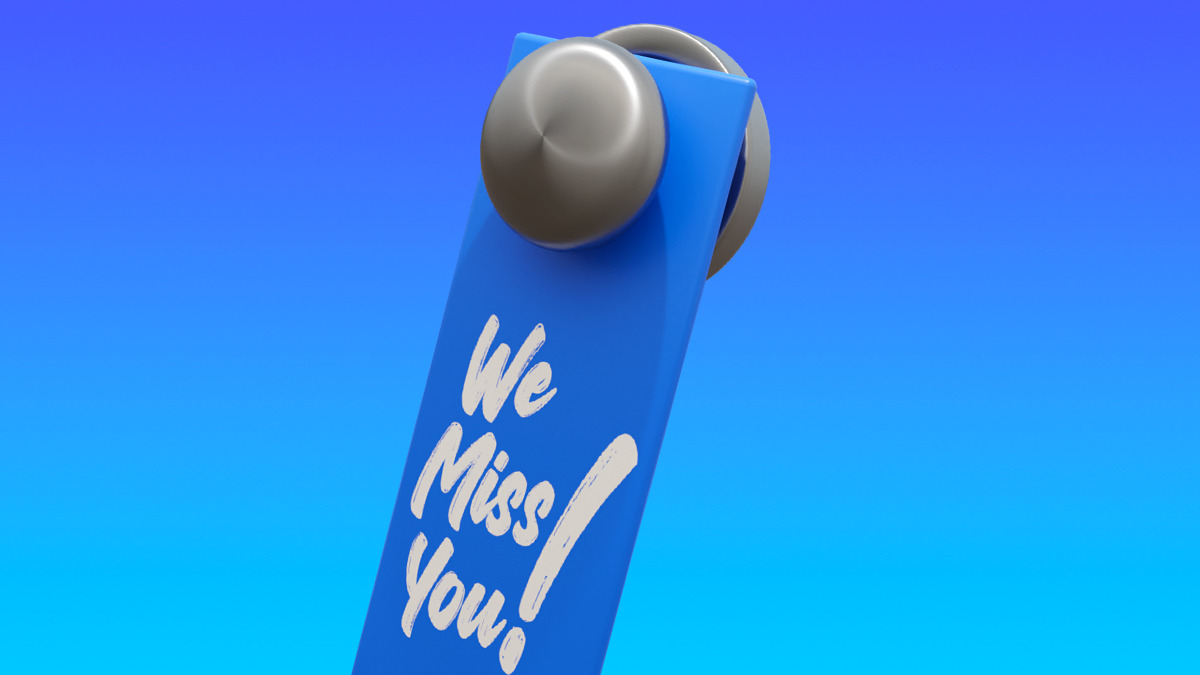
Re-engagement emails are one of the best-kept secrets for keeping your email list engagement rates high.
In this post, we'll show you:
- Why re-engagement email campaigns are important
- How to write effective re-engagement emails
- 10 great re-engagement email examples
But first, let's talk about decay. Specifically, email list decay.
Email list decay (aka "email address decay" or "email database decay") is the percent of email subscribers' addresses that are abandoned or go inactive.
List decay can happen for many reasons, like someone leaving a job or creating a new email address and abandoning their old email address. Or unsubscribing from an email list.
The exact rate of email list decay varies, but it's estimated to be about 22% to 30% a year. This means that if you don't purge your list of inactive subscribers on a regular basis, you'll be sending a lot of emails to addresses that aren't really active. This will cause your emails' engagement rates to drop, which can in turn start to suppress the results from your email marketing overall.
Not good, right?
So what to do? The best practice we recommend is to remove any subscribers that haven't opened one of your emails in the last six months. At the very least, if someone hasn't opened an email from you within the last year, it's time to say goodbye.
Some email marketers use an even tighter timeline. In this email from Marketing Brew, they mention that the recipient hasn’t opened an email in three weeks. Do keep in mind that Morning Brew sends emails daily, but if they’re this diligent, they probably have an exceptionally clean list.
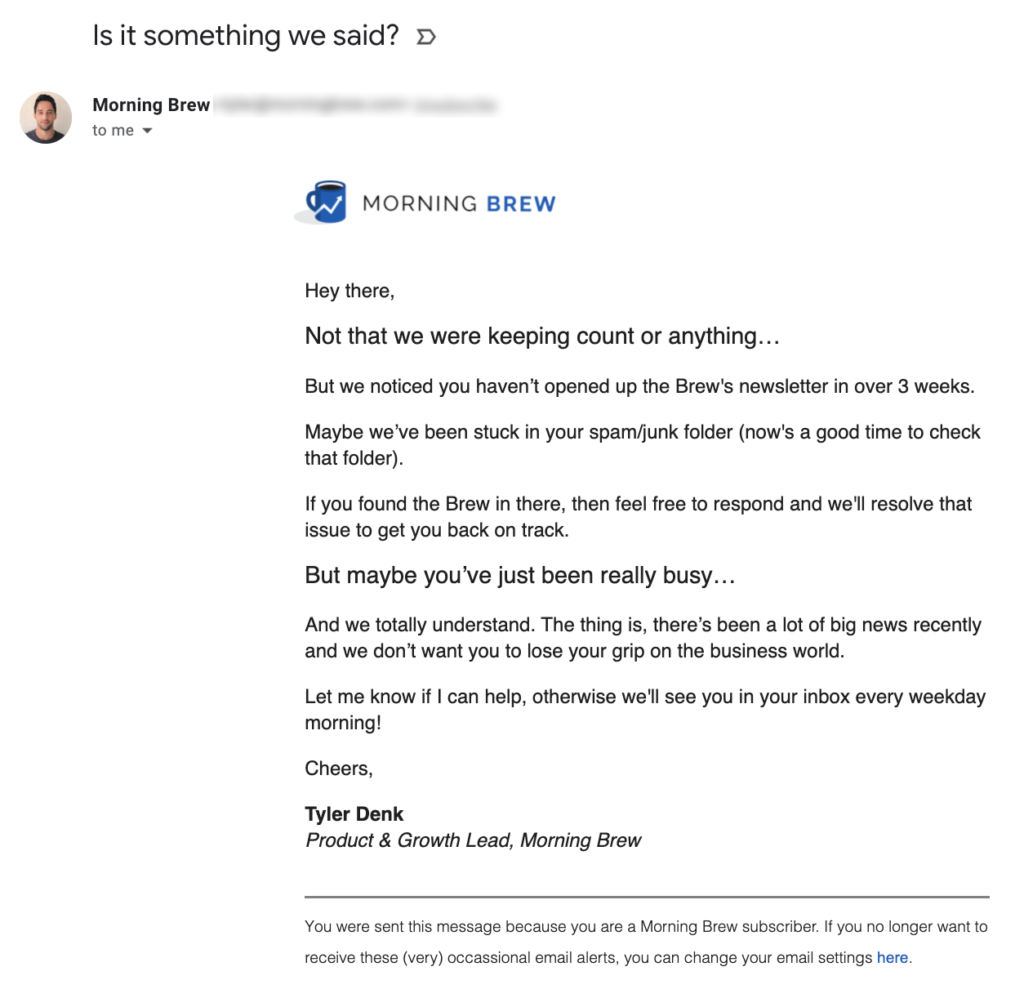
For more information about why and how to clean your email list regularly, see our blog post, Why You Should Delete a Bunch of Your Email Subscribers Right Now.
How to reactivate inactive subscribers
If you just thought, "Yikes - I don't want to lose all those subscribers!" we hear you, but honestly, most of them were "lost" already. Keeping those inactive email subscribers on your list is just hurting your inbox placement rates. However... if you do want to try to get some of those inactive subscribers back before you delete them, a re-engagement campaign (also known as a "win-back email") is your best bet.
How effective are re-engagement emails?
So you want to keep your list "clean," but you also want to retain as many active subscribers as possible. Re-engagement campaigns are a great way to accomplish both those goals... but don't expect every inactive subscriber to become active again.
Most email win-back campaigns have a success rate of 14% up to 29% in the best-case scenario.
Several email marketing studies have found that sending a series of emails may be more effective than sending just a single email. A re-engagement sequence of three emails appears to be the sweet spot.
So what else works for re-engaging subscribers? Honestly, it depends on your list and what your subscribers respond to. Every list is different. One recent study found that several different tactics will work, but no one tactic significantly outperformed the others.
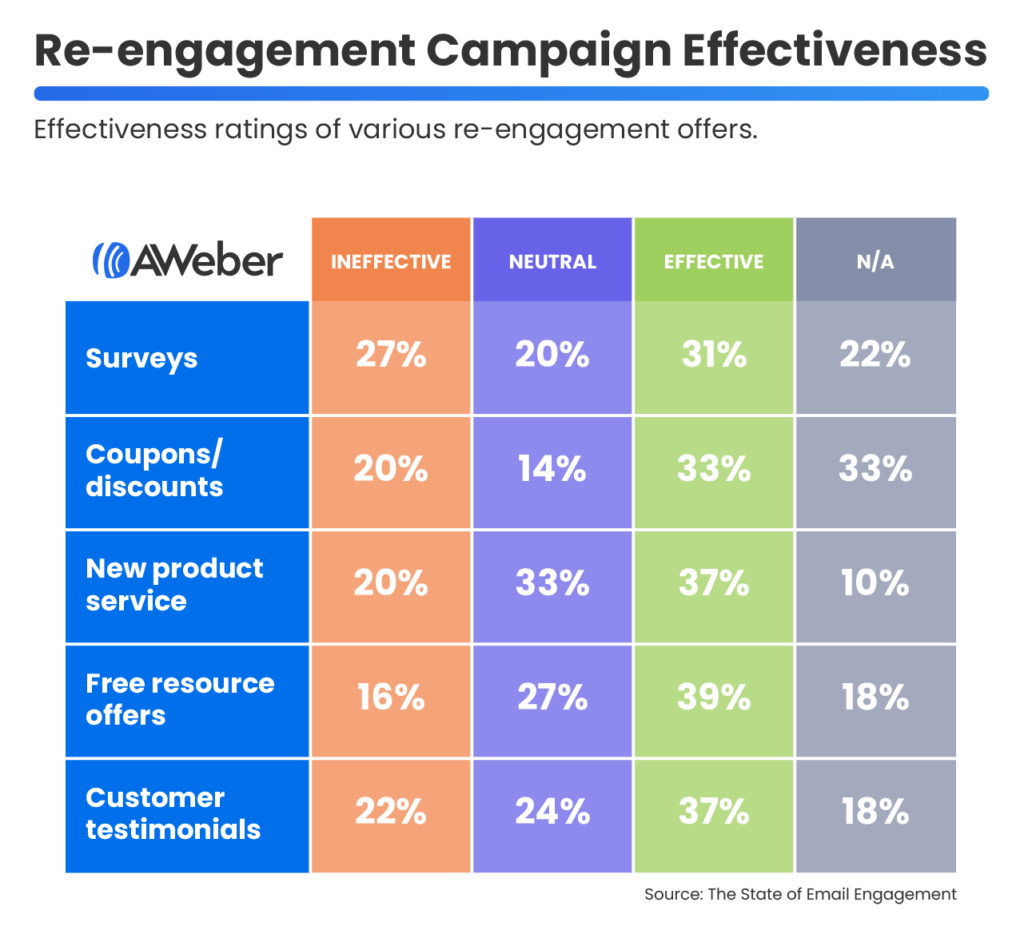
While this means there's no magic bullet for what to put in a win-back email, that table should give you lots of ideas of what you could include. Here are a few ideas:
- Surveys
- If your subscribers aren't responding to what you've been sending, try asking them what they would like to get from you.
- Coupons and discounts
- If you're in ecommerce, the classic way to win back inactive customers is to send them a juicy discount coupon. Consider making this a dollar off discount rather than a percent off discount; one study of win-back campaigns found that dollar off discounts activated more subscribers.
- New products and services announcements
- Announcements are ideal emails to send out if you haven't mailed to your list in a few months.
- Free resources
- This is another excellent thing to send if you haven't emailed your list in awhile. A high-value digital product, like an ebook or a course, can be a great way to demonstrate that it's worth their time to be on your list.
- Customer testimonials
- Use testimonials with other types of content mentioned above. For instance, share a few customer testimonials about a new service you have.
How to write re-engagement emails
The goal of your re-engagement campaign is to get people interested in your emails again. So every element in the email - the subject line, the content, and the call-to-action - needs to support that goal.
The Subject Line
For re-engagement email subject lines, we find the best ones specifically reference the goal: to win back your subscribers!
Here is an example of an email from Tomasz Borys at Kissmetrics:

You can also take a more personal approach, like this email from Threadless:

Both subject lines work well, but grab the reader’s attention in different ways: A simple “We miss you!” lets the subscriber know that the sender appreciates their readership. It also feels more conversational. On the flip side, “Do you still want updates from us?” is direct and inquisitive. It tells the subscriber that they care about their time and want to make sure they get something out of the relationship.
I encourage you to review your past emails to see what’s working for your specific audience. Look for common themes like subject line length and tone – these are elements you’ll want to try to replicate.
You can also try using personalization, like including your subscribers’ first names in the subject line. It’s no secret that personalization helps you connect with your subscribers and stand out a little more in the inbox. For example, the email from Threadless could have gone one step further by saying, “We miss you, Sam!”
Since these details depend on what your audience responds to, try to test different variations and find that sweet spot.
The Email Content
Most re-engagement emails' content is short - like two or three paragraphs. All you need to do is to make the purpose of your email clear: "Do you still want to get emails from us?" and then perhaps explain the value of your emails.
Remember: these are people who signed up to receive messages from you but at some point stopped reading. They wanted to hear from you before, so how can you get them re-interested in what you have to say? Ask yourself a few questions:
- What did my subscribers sign up to receive originally?
- Am I continuing to send them content based on their original expectations?
- Did I change anything in my email strategy that might have caused them to stop engaging with my content?
- What can I offer to pique their interest again?
Once you have those answers in mind, it’s time to start writing your email.
Here’s an example of a re-engagement email we sent to our inactive blog newsletter subscribers:
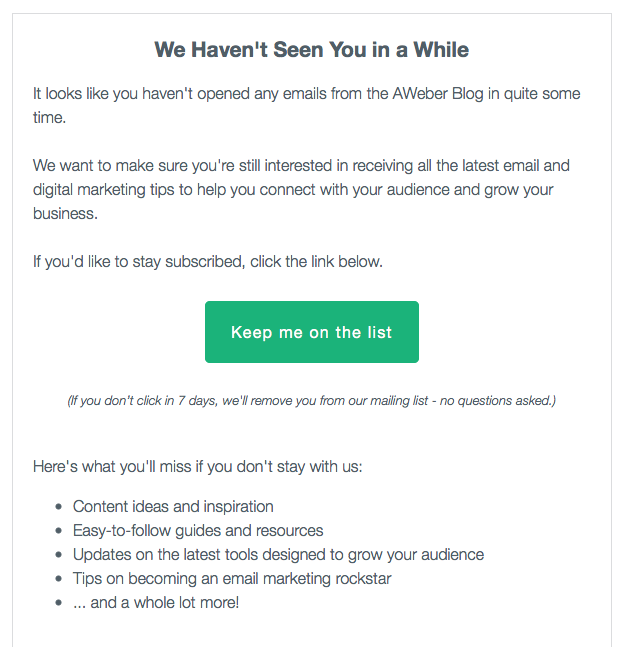
Its format is very simple, and makes for a good template for any re-engagement email:
- You haven't opened any emails from us in a while
- We want to make sure you're still interested
- If you still want to be subscribed...
- Click this button to stay on the list
That's it. That's all you have to say in a re-engagement email if you want to keep it simple.
You may notice, though, that we added a section about the value of our emails. It's still short - just one sentence and a few bullet points. The shorter your email is, the more likely people are to read it and click the button.
If your inactive subscribers haven’t read your emails in a while, they might have also missed important updates or products you’ve released. Getting them up to speed might get them re-interested in your content, so you might want to add a short bullet list of your "greatest hits," whether those are products, content, or a promotion you're running.
Incentives
Speaking of promotions... offering an incentive like a white paper or coupon code might also help you re-engage subscribers. If you hooked them onto your list with a piece of content in the past, consider how you might be able to repeat that success during your re-engagement campaign.
Check out this example from Paperworks, a stationary and premium paper provider:
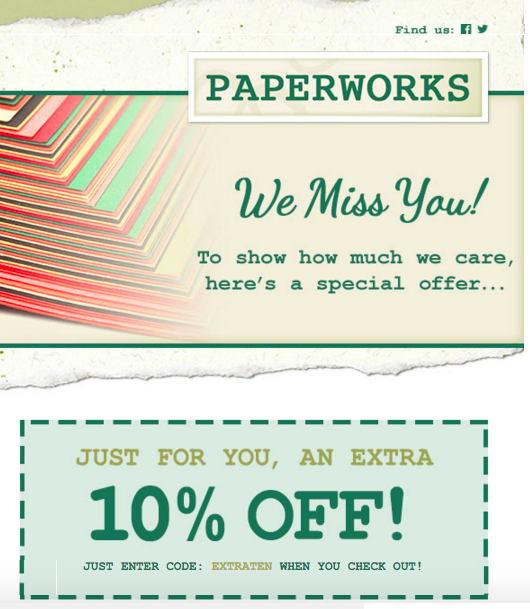
Offering a special discount is a great way to get subscribers interested in your emails again. Not only are you giving your subscribers something in exchange for their time and attention, but you might even get another sale out of it as well.
Invite Feedback
To help you learn more about why subscribers grew disinterested in your content, asking them for specific feedback could help fill in the gaps.
Was there something you could have done better for these subscribers? What made them stop engaging in the first place? If you make a subscriber feel like their opinion is truly valued, they may want to stick around. Plus, this will give you valuable insight into their needs that you wouldn’t get anywhere else.
As you get feedback and notice common themes, you can use that to implement in the future.
The Call-to-Action
The whole point of your email is to prompt subscribers to take an action, so make sure your emails have a call to action that is bold and clear.
To increase the click-through rate, limit yourself to one call-to-action. Too many CTAs can be overwhelming, decreasing the chances that your subscribers will engage at all.
Whether you ask them to stay on your list, learn more about a product or service, or download an incentive, make sure it’s easy for them to do so.
Check out this email and CTA from Grammarly:
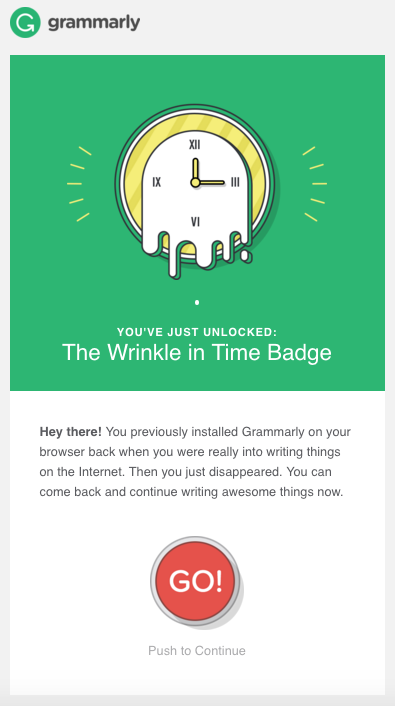
While having one call to action is the classic approach, many of the re-engagement email examples we've seen lately do include an unsubscribe link.
Like this email from a non-profit organization:
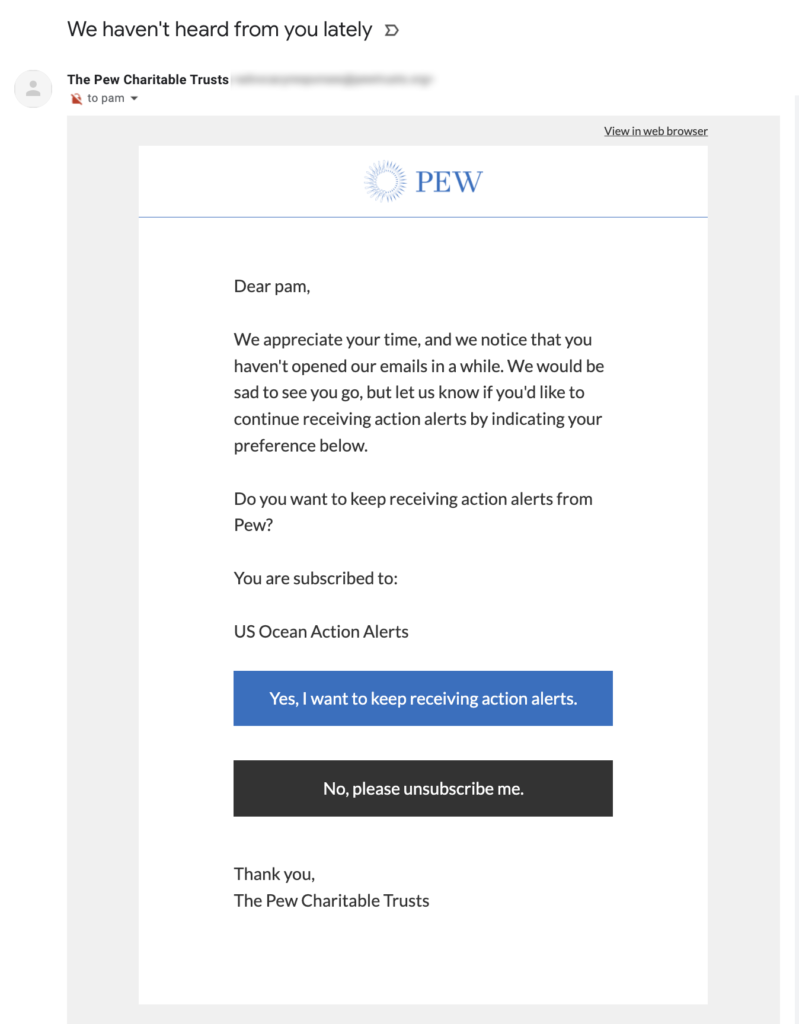
And some re-engagement emails even let subscribers choose to get emails less often:
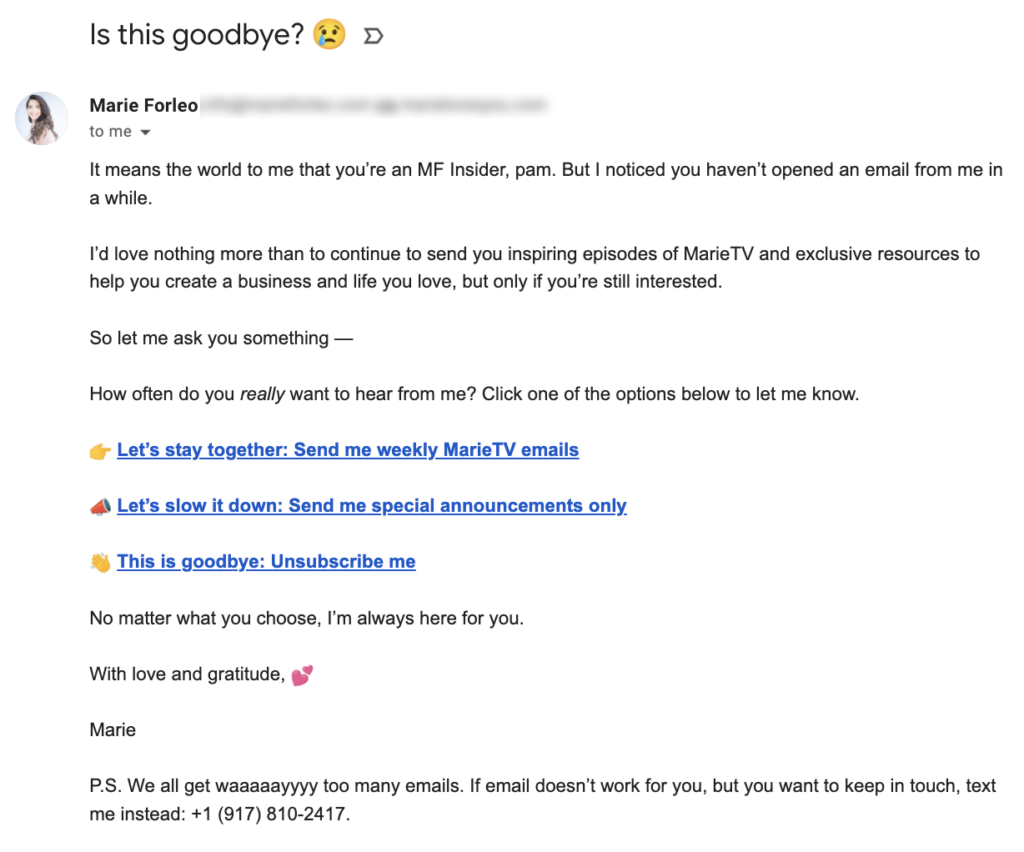
Re-engagement email sequences
All email lists are different, so what works best in one situation may not work so well in another. One message might do the trick, but you could be more effective by sending two or three emails to warm people up and get them re-activated.
Since these subscribers are already less engaged, aim to keep your campaign short. Send an email, wait a few days and see who’s interacted with your content.
If they’ve clicked through to your content or stated they want to remain on your email list, then great! They can stay on your list and continue to get your awesome emails.
Here are two re-engagement email examples that were sent a few days apart.
This is the first one. Notice how short it is?
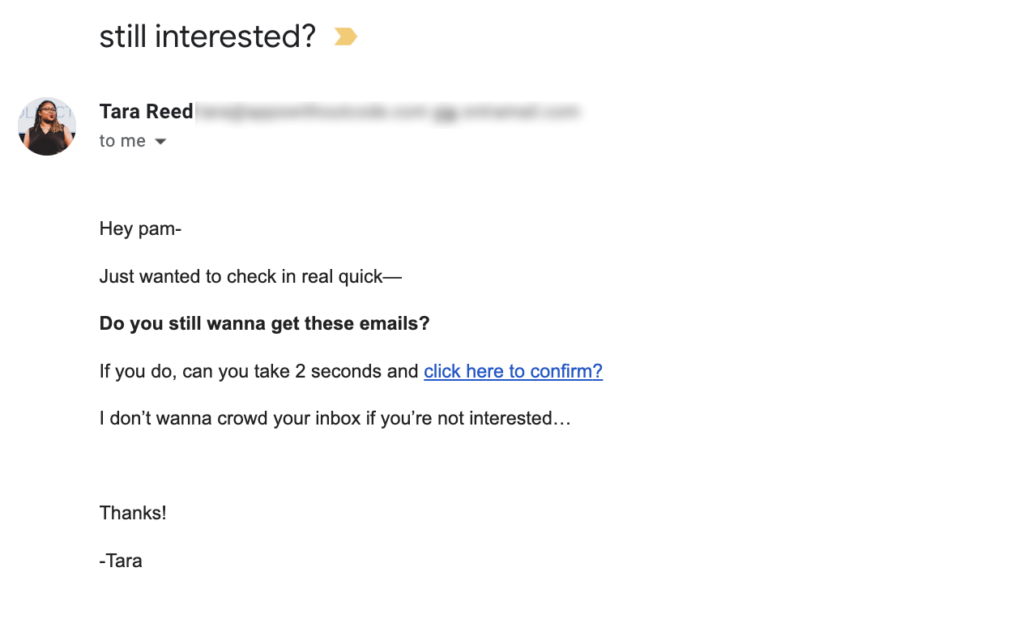
And here's the next one, sent two days later:
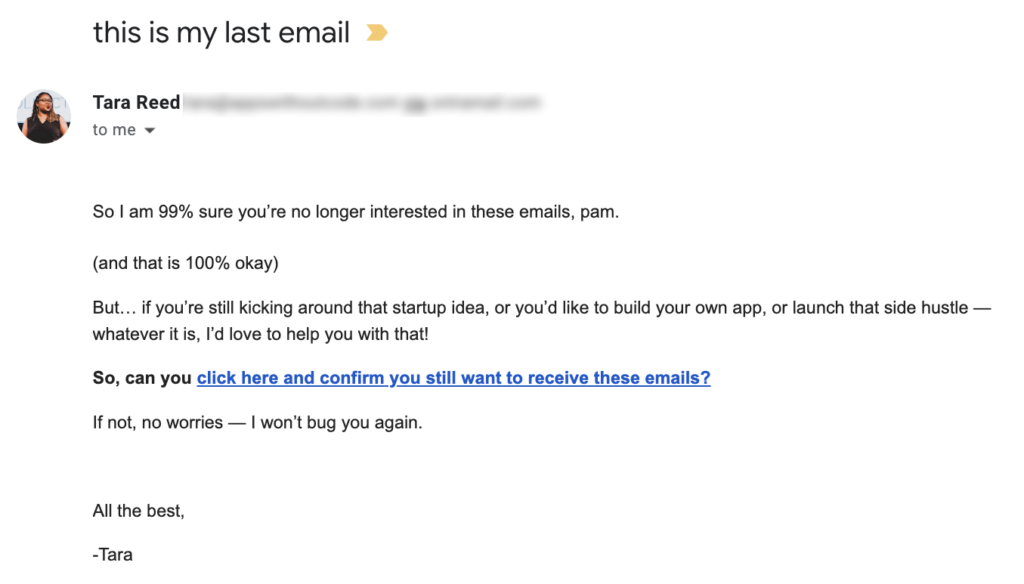
What if they didn’t open the email?
You’ve taken the time to craft your re-engagement emails, but some subscribers haven’t responded at all. In that case, it’s time to say goodbye.
And hey, that’s ok!
You’ve done what you can to win them back, but if they don’t want to receive your emails, it’s better to let them go. Not only will they appreciate a cleaner inbox, but it’ll also help boost your email deliverability – which will improve your email marketing in the long run.
We know that sometimes, it can be really hard to write your emails. That’s why we created our What to Write in Your Emails guide and course, complete with 45+ email templates. It will save you hours of work every month.
How do you plan on running a re-engagement campaign of your own? Leave a comment below to share your ideas.
The post Re-Engagement Emails: 10 Examples of How to Win Back Email Subscribers appeared first on AWeber.
from AWeber https://ift.tt/GoH7Ueg
via IFTTT
No comments:
Post a Comment